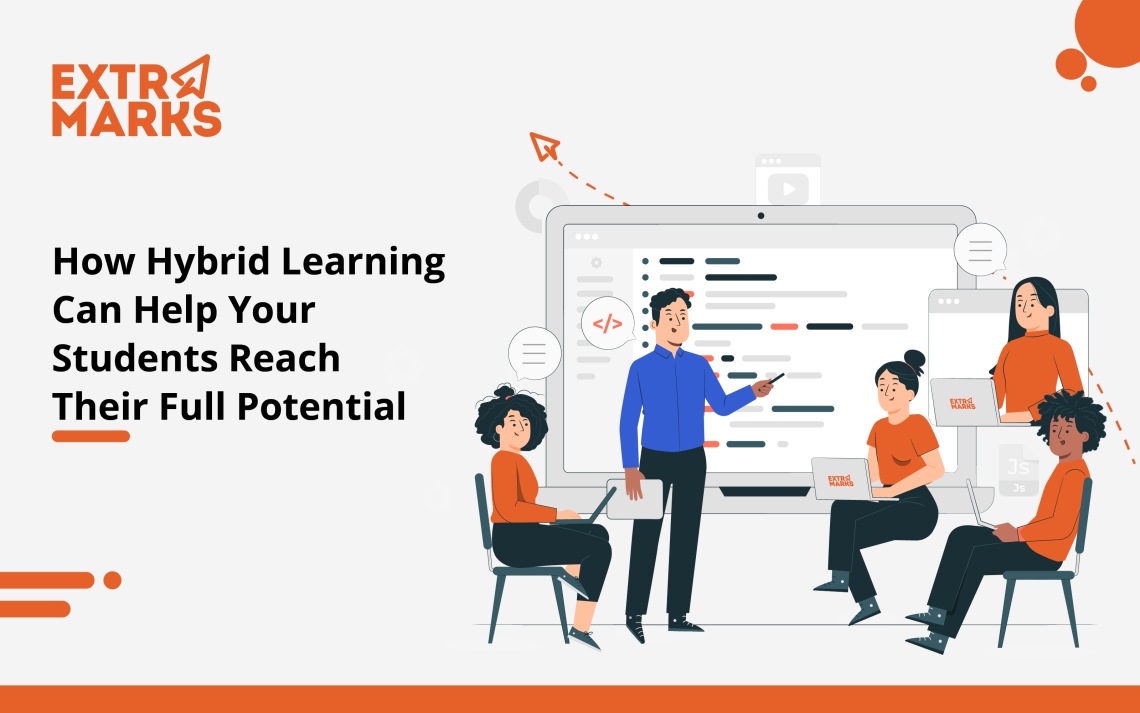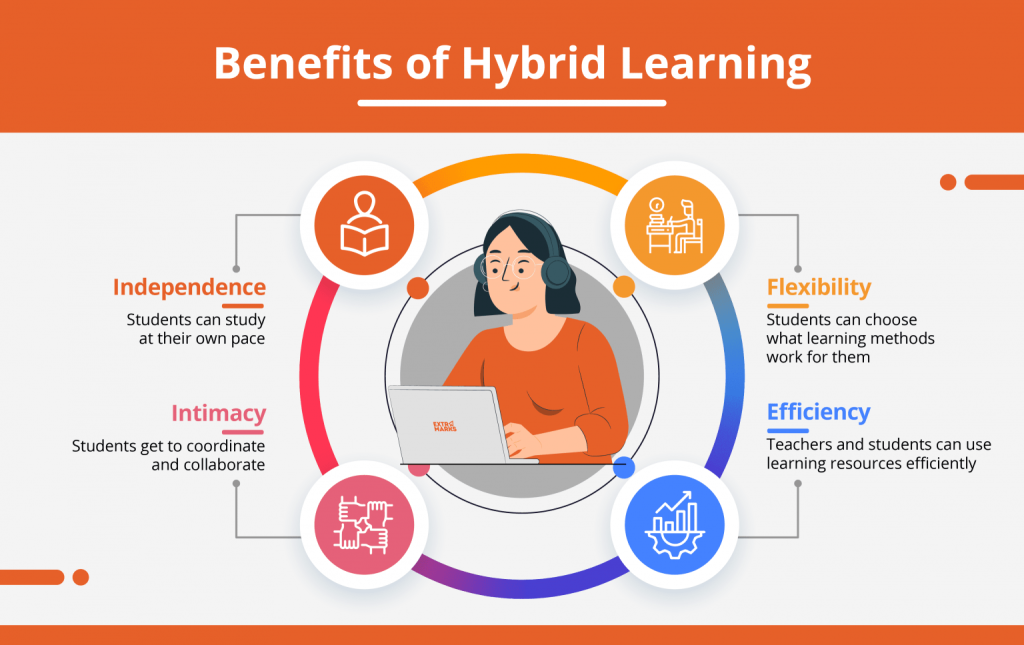How Hybrid Learning Can Help Your Students Reach Their Full Potential

In 2023, our lives have been irreversibly changed by technology. From ordering groceries to searching for a new home, everything we need can be done at the click of a button on our smartphones without even having to get out of our seats. The pandemic forced the world to rapidly adopt technology in order to work, socialize and even learn. After it ended, it made little sense to give up its benefits. New models of education quickly became the norm, one of the most successful of which is hybrid learning.
Technology now enables teachers and students to communicate and share ideas virtually as easily as they would in a physical classroom. This has helped schools around the world experiment with and adopt new learning models which grant novel benefits to learners, teachers, and even schools. So what is the hybrid education system?
Why Moving to a Hybrid Education Model is a Must in 2023
With just how simple technology has made our lives, it’s incredible to think that education has stayed largely the same over the last century. Hybrid education is the obvious next step in the evolution of our educational system. Being able to access learning without being physically present in the classroom will help streamline the educational process for numerous students. The changes we’re seeing in education today have been a long time coming.
What Is Hybrid Learning?
Hybrid learning is a type of learning model where teachers take classes online and offline at the same time. Students get to choose whether they want to attend the virtual class or the in-person one. It combines elements of both formats of learning to provide students with a holistic experience.
Teachers are given access to various tools like video conferencing hardware and software to teach their online students during their physical classes. Classes can also include a variety of asynchronous learning elements as well like online assignments or pre-recorded lectures.
The main advantage of hybrid learning is that a student’s access to education is not hindered by distance or other external factors. If students can’t make it to the physical classes, they can use various online tools or attend virtual classes to keep up with lessons unhindered.
What Are the Different Approaches to Hybrid Learning?
The basic idea of hybrid learning, that students learn online and offline at the same time, is very simple. However, you need to create a tailored approach for your hybrid classroom based on the specific program that you are teaching.
Schools around the world have developed several methodologies when adapting to teaching hybrid courses. In-person lessons are found to work best for group work where communication in collaboration is essential. What’s more, students expect certain specific values that can’t be attained online when attending physical classes.
Here are some activities that could offer students this value during synchronous classes:
1. Lectures that feature a Q&A session
2. Debates and group discussions
3. Sessions for setting group agendas
4. Group feedback sessions
5. Brainstorming sessions
Asynchronous assignments are useful in helping students approach self-study and build proper time management skills. Teachers can use hybrid online learning to offer students asynchronous assignments they can use during independent learning.
Here are some asynchronous assignments that can be beneficial to students:
1. Online activities and tests
2. Ongoing group discussions or forums
3. Written, video or audio lectures
Asynchronous activities need not necessarily be online activities. For example, completing a simple experiment at home and creating a note on observations can be an easy asynchronous activity. Each student can complete the experiment in their own time without needing to watch the teacher perform it in the classroom.
It is beneficial to distinguish hybrid learning into synchronous learning and asynchronous learning rather than just online and offline learning.
Benefits of Hybrid Learning

Different methods of learning have their specific advantages and disadvantages. Since hybrid learning is a combination of both in-person and virtual learning, we can apply it in a way that creates a learning experience with the advantages of both and fewer weaknesses than either form. The advantages of hybrid learning include:
Flexibility
Several schools have chosen to go with a hybrid learning method because of the flexibility it offers. This includes creating a flexible learning schedule, choosing various teaching modes, and offering students a choice in how they engage with the learning methods, and how they collaborate with their classmates and interact with their teachers. Students that cannot attend in-person sessions are offered the option to attend classes from home.
Intimacy
Hybrid learning offers students the opportunity to learn in-person. This is a tried-and-tested method of learning that provides unmatched immediacy and intimacy in academic discussions. Learning can be greatly accelerated when students can engage in real-time with their peers. In-person classes are great for group work, presentations, Q&A sessions and conversations. Using these methods, students can form meaningful interpersonal relationships which can then be moved online.
Independence
Online learning offers students the freedom to study independently. It teaches them to manage their time properly. Students who can manage self-study properly will thrive under the freedoms it offers. These include the freedom to study from the place of their choosing. The freedom to revisit topics multiple times, the freedom to choose their own pace and the freedom to discuss the materials with their peers.
Efficiency
Several times, we have wondered why long meetings cannot be replaced by simple emails. Similarly, it can become annoying for students to attend in-person classes to complete a plethora of independent online work. This sort of work can be assigned to students with the flexibility to complete it at the place and time of their choosing. Doing this requires educators to plan their schedules properly, knowing which classes need to be taken online and which classes require in-person attendance. In this way, teachers can take into account which resources are needed for each class and optimize their use.
How is Hybrid Learning Different From Other Online Modes of Learning?
There are various online modes of learning including online learning, blended learning and experiential learning. Each of these differs in some way from hybrid online learning. Let’s understand how.
Online learning aims at teaching students completely online. It lacks the in-person experience offered by hybrid learning. During the pandemic, it was the primary method chosen by educational institutions. Since there is no in-person aspect, it can often feel impersonal.
Blended learning uses both online and offline methods of learning, however, in blended learning all students are made to attend offline teaching sessions where classes are assisted with digital learning techniques. It differs from hybrid learning since it does not offer students the opportunity to choose how they wish to learn.
Another method of learning is experiential learning. In this method, students are allowed to explore their interests through relevant activities under the guidance of their teachers. While these hands-on experiences cannot be implemented in hybrid learning models, the asynchronous aspect of hybrid learning still allows students the opportunity to learn independently.
How to Create a Successful Hybrid Learning Environment
1. Choose Your Goals
Determine what you plan to achieve with your hybrid classes and set long-term and short-term goals. You can explain these goals to your students. You can structure your lessons around these goals by correlating individual assignments to each goal.
2. Choose Which Learning Techniques to Use
Once you have determined your course structure, you will need to choose which methods are best to teach which modules. Certain activities require face-to-face classes while others might be better served with asynchronous learning. Plan and assign the right teaching methods to each activity and module in your course.
3. Create Your Source Material
Creating the source content includes creating assignments, finding the right resources, sourcing video content, and finalising your syllabus. Once you have gathered the source material, your hybrid learning environment is complete.
Tips to Succeed With Hybrid Learning
The following tips can help you succeed when using hybrid learning for your class:
1. Choose your goals
2. Choose between synchronous and asynchronous elements
3. Make a schedule
4. Create your online content before the semester begins
5. Plan your resource use
6. Don’t overload your students
The Future of Hybrid Learning
Many preeminent experts now believe that online learning methods will continue to be used in higher education. With the continuous use of these models by various educational institutions, it is predicted that they will continue to get more refined and improve further. Hybrid learning will also impact how parents choose which educational institutions are right for their children, and in turn, how institutions choose their faculty. Faculty who have experience in hybrid learning methods will receive preference over faculty who have difficulty understanding and using these techniques.
While hybrid learning is certainly beneficial for students, it can be challenging to implement these methods without the right infrastructure to do so. Thankfully, by using the Extramarks app, teachers can set up their hybrid classrooms with ease. Set up your hybrid teaching environment today. Sign up now.
Last Updated on August 9, 2024









